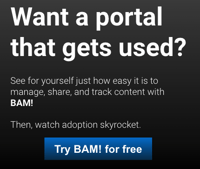Don’t you think you should stop using email…so much? Let’s face it, the shine has worn off.
“Say it ain’t so!”
Recently, one of our designers shared with us an excellent article on giving quality feedback via email. It’s a great read and I agree with everything it has to say except the part about email.
Here are my issues with email:
- Signal-to-noise ratio decreases steadily as emails are replied to and forwarded.
- Two different people may see different parts of the whole communication, depending on when and where they were included in the thread.
- Information taxonomy (categorization, cross-referencing, indexing) is trusted to the hands of individual users with vastly different organizational abilities.
- It allows for no common taxonomy or organization.
- It is very difficult to get off a thread with multiple actors once you’re on it (go ahead, try telling the fifteen people on the thread to all make sure they remove your email when they hit “reply all”).
- HTML-formatted email is a morass of inconsistent, archaic standards, listlessly implemented by multiple vendors who are still attached to their awful proprietary idiosyncrasies.
- It is painful to try to untangle an email thread if you are a newcomer.
- The format of email encourages people to waste time with outmoded formalities and artifacts.
- In a painful effort to make email seem more sophisticated, companies waste time creating stuffy “virtual letterhead” that generally renders like garbage on most mail clients.
- You can’t hyperlink to an email.
And I’m not the only one who thinks this.
I’m not going to elaborate on all of these points, but I do want to touch on some of them. I plucked an email thread out of my inbox to illustrate some of the problems with email. I picked one that exposed most of these problems (it wasn’t hard). I took that email and then I started redacting useless, outmoded, and redundant information. Here’s a filmstrip of the process:
- The original, unmodified email.

- Automatically inserted signatures removed. I don’t need that stuff! It says right in the header what your name and email address is. I probably already know what your website is, and I can find your phone number if I need it. I will never need your fax number. I promise. Seriously. Not. Kidding. Even if I did need any part of this data, I wouldn’t need it twenty times.

- Then I removed all the salutations and closures. The “Dear So-and-so,” and the “Best, Jimbo” lines. We feel compelled to add these tidbits because…well, that’s how we’ve always done it. Those of us who are old enough remember memorizing the “parts of a business letter.” I’m not saying throw courtesy or politeness out the window, mind. I’m just questioning whether anyone would really miss these little pleasantries, or think one rude for omitting them.

- Then I removed all useless header information. The “To” line (almost always useless), the “CC” line (ditto), and the “Subject” line. I have no particular objection to subject lines, but I need to see it once, at the top of the email. I do not need to see “Subj: Re: Re: Re: Re: Quarterly Sales Projections for Novelty Mustache Items” a dozen times.

- Then I removed pointless pleasantries. Again, I am not anti-politeness. Far from it! But really, do you honestly need to say “feel free to reach out if you have any questions”? I know that. You are friendly and helpful, and if I have any questions, I will absolutely feel free to reach out. I also removed any “have a good weekend” and the like. Yes, these decorations clearly indicate that I’m dealing with a civilized person who cares about my feelings, but mostly we all just want to get our work done so we can enjoy that weekend.

- Finally, I removed all scheduling-related data. Proposals about when to have meetings, due dates, etc. “Wait a darn minute,” I can hear you saying, “that’s important information!” And so it is. But why aren’t you using a calendar? Why aren’t you recording due dates in your project scheduling software?

Now look at version #6 in the image above. All of the white text is the forest, and the dark stuff is the trees. And I can’t see the forest for the trees. This is the signal-to-noise ratio I’m referring to. I have to scroll through the entire email and scan it all to extract the tidbits that are actually pertinent.
Now that I’ve laid out my issues with email, and illustrated some of them with a concrete example, let’s talk about what we should be using instead (after that, we’ll conclude with a conversation about what email is still good for).
1. Issue Tracker
Heaven knows everyone at Pop Art is tired of hearing me go on about the merits of issue tracking. For the uninitiated, an issue tracker (sometimes also called bugtrackers or ticket trackers) are systems that allow you to enter, categorize, and assign units of work. Sometimes it’s a defect (bug) and sometimes it’s a feature.
A pretty common example of using email when you shouldn’t is when someone emails me this: “The client just found that the Whack-A-Mole minigame doesn’t pop up when you click on the ‘Waste Time’ button in Firefox.” That’s a defect, and it should be in the issue tracker. Then, when the client calls back to say “it also doesn’t work in Safari”, do NOT email me that information: annotate the issue with it. Ideally, you have a client-facing issue entry system so that you can normalize the defects and feature requests that are getting sent your way, triage them, and massage them into a format you can use.
2. Blog
If what you want to communicate has a broad audience, and you feel that it’s on-brand and useful to your agency (and blog-sized), why don’t you write a blog post about it instead of sending that email? If you must, send a staff email pointing people to the post.
3. Twitter
If what you want to communicate is 140 characters or less, and has broad appeal, why not tweet instead of emailing it?
4. Wiki
Wikis are great. You should use them. If you need to write about something that has some permanence, or needs to fit into a certain categorization, consider writing (or adding to) a wiki page instead of writing that email. If it’s something that people are going to refer to repeatedly, you will get more mileage out of a wiki. Wiki pages can be hyperlinked and organically discovered. They’re great for collaboration. Use them.
5. Forums, Surveys, and Scheduling Apps
When you need to get a bunch of people to answer a bunch of questions, consider SurveyMonkey. It’s easy and it’s free (for simple, ad-supported surveys). If you need an ongoing discussion about something, you need a forum, not emails. Consider Jeff Atwood’s brilliant Discourse. If you’re trying to schedule a company picnic when the most number of people can come, your organization’s calendar software (probably Microsoft Outlook or Google Apps) can do that. Sometimes, though, it’s easier to just throw it on Doodle.
The Holy Grail
For me, the holy grail would integrate all (or most) of these things. Issue tracking, forums (preferably backed by Discourse), blogs, and wikis could all be brought together with the same brilliant software package. No one’s done that yet. But they will.
When It’s Appropriate to Use Email
I suppose one way to answer this question would be this algorithm:
- Is this communication more appropriate for a blog, wiki page, issue, tweet or survey? If so, don’t send an email.
- Are you absolutely sure?
- Seriously, have you really thought through #1?
- Okay, send your email.
So let’s talk about some of the reasons we might get down to #4:
- A potential client sends you an email. You should reply in email. It’s personal, it’s polite, it’s warm. All of those pleasantries now make sense and are perfectly appropriate.
- You want to have a (work-related) philosophical discussion with one or two people. There’s nothing really actionable; it’s just musing or random thoughts. Okay, send that email…but if the email thread starts gathering more people, or goes on for a long time, or has a lot of replies…maybe it’s time to move it to a Discourse thread, or a wiki page.
- That one client who just refuses to use your issue tracking system sends you a bug report. Eh. You can’t win ’em all. Send them a polite reply, and tell them they can reference issue #3902 (or whatever). Now, whenever email about that issue arrives, it’ll most likely be in the form of a thread, and the issue number will be in there. You can annotate the issue as needed.
- You need to have a confidential dialog with someone, and you don’t want it to be discoverable on your wiki or whatever. Mind, I’m not suggesting you use work email for inappropriate communication. You’re at work, respect that.
All of this takes discipline. We’re all busy people, and learning replacing bad habits with good ones is time-consuming and sometimes unpleasant. I think you’ll find the payoff worth it, though. There are great tools out there, and I promise they will make your life better.
Please send any comments about this blog post to ethan.brown@popart.com.
(Just kidding. There’s a doohicky below you can use to post your comments.)


